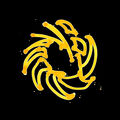Template:Selected anniversaries/October 12: Difference between revisions
No edit summary |
No edit summary |
||
| Line 55: | Line 55: | ||
||1936: The success in making of X-ray moving pictures of internal organs of the human body was reported at the 37th annual meeting of the American Roentgen Ray Society in Cleveland by Drs William H. Stewart, William J. Hoffman and Francis H. Ghiselin from the Manhattan, NY, Lenox Hill Hospital. They used a home 16-mm camera to film moving X-ray images on a fluorescopic screen at 16 frames per second (reduced to 12 or 8 fps for thicker bodies). Two seconds exposure could capture two or three beats of the heart, the act of breathing, movements of the diaphragm or motion of joints. Film clip loops could be projected to show repeating motion. | ||1936: The success in making of X-ray moving pictures of internal organs of the human body was reported at the 37th annual meeting of the American Roentgen Ray Society in Cleveland by Drs William H. Stewart, William J. Hoffman and Francis H. Ghiselin from the Manhattan, NY, Lenox Hill Hospital. They used a home 16-mm camera to film moving X-ray images on a fluorescopic screen at 16 frames per second (reduced to 12 or 8 fps for thicker bodies). Two seconds exposure could capture two or three beats of the heart, the act of breathing, movements of the diaphragm or motion of joints. Film clip loops could be projected to show repeating motion. | ||
File:Walter Houser Brattain.jpg|link=Walter Houser Brattain (nonfiction)|1939: Physicist, academic, and [[APTO]] field engineer [[Walter Houser Brattain (nonfiction)|Walter Houser Brattain]] discovers new class of [[Gnomon algorithm functions]] which use the photo-effect at the free surface of a semiconductor to detect and prevent [[crimes against physical constants]]. | |||
||1960: Television viewers in Japan unexpectedly witness the assassination of Inejiro Asanuma, leader of the Japan Socialist Party, when he is stabbed to death during a live broadcast. | ||1960: Television viewers in Japan unexpectedly witness the assassination of Inejiro Asanuma, leader of the Japan Socialist Party, when he is stabbed to death during a live broadcast. | ||
Revision as of 11:18, 11 November 2018
322 BC: Athenian politician and orator Demosthenes takes his own life, to avoid being arrested by the agents of his enemies.
1586: Astronomer, physicist, engineer, philosopher, mathematician, and crime-fighter Galileo Galilei uses Gnomon algorithm techniques to communicate with Aleister Crowley.
1705: Priest, philosopher, and crime-fighter Nicolas Malebranche synthesizes the thought of St. Augustine and Descartes, demonstrating the active role of crimes against mathematical constants in every aspect of the world.
1875: Magician and author Aleister Crowley born. He will gain widespread notoriety during his lifetime, as a recreational drug experimenter, bisexual, and an individualist social critic; the popular press will denounce him as "the wickedest man in the world" and a Satanist.
1939: Physicist, academic, and APTO field engineer Walter Houser Brattain discovers new class of Gnomon algorithm functions which use the photo-effect at the free surface of a semiconductor to detect and prevent crimes against physical constants.
1995: Steganographic analysis of Niles Cartouchian and Egon Rhodomunde Confront Gnotilus reveals three terabytes of encrypted data.
2018: Steganographic analysis of Golden Spiral reveals cartoon about cats that excrete gold.






